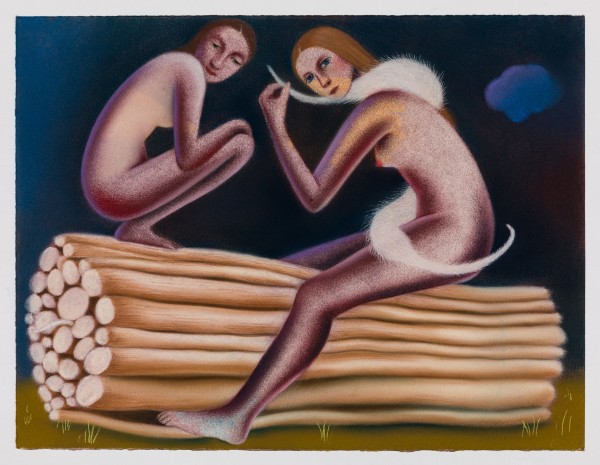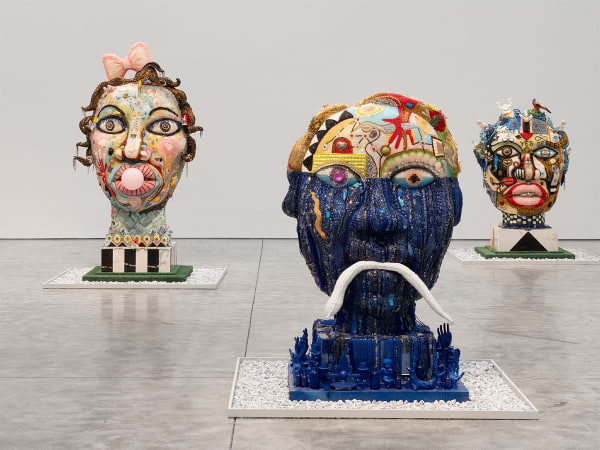Sara Anstis: Procession
Past exhibition
-
-
Kasmin is delighted to present Procession, the first New York solo exhibition of work by London-based artist Sara Anstis. Anstis’s evocative paintings and soft pastels on paper mine art history to render a darkly humorous universe defined by its rich layers of meaning and symbolism, its indeterminate, primarily nocturnal landscapes, and a population of deftly lit figures that seem to hark from the realms of folklore, dream, and mythology.
-
“In this series of works I wanted bodies that could occupy several temporalities, where they are crouching and standing up, about to depart and having just arrived. There are forces applying pressure to all of them and making them act and bend in strange ways, yet I am sure that they will make it through. They are strong.” –Sara Anstis
-
-
Comprised as a series of tableaux depicting scenes from a funeral procession, the exhibition presents figures on a ritualistic or ceremonial journey, weighed down by, Anstis writes, “passengers, free-loaders, dogs, memories of people no longer alive, memories of past selves at different ages, exhaustion, the thought of the long journey ahead or an anticlimactic arrival at their destination.” In Knot (2022), a figure appears to mourn as she ties the ankles of another to a pyre, and in The Visit, a portrait of a face tied to a tree serves as a memorial. Loaded with narrative possibilities, Anstis’s work exudes both a pictorial and psychological complexity.
-
-
The figures presented in Anstis’s landscapes are resolutely assertive of their autonomy even as they exist peripatetically and close to the margins of survival. As they hunt, swim, play, rest, and sleep, their interdependence with nature implies an order beyond comparisons with the European bourgeoisie concept of “civilization”. Far from an appeal to heteronormative voyeurism, their nakedness, situated in the fecundity of the landscape, is paradoxically highly sexed yet unsexual.
Anstis’s works are steeped in literary history and the founding oral traditions of fables and folklore, and yet they reimagine the typically masculine narrative arcs of climax and denouement that are foundational to the canonized “hero’s journey”. Instead, the works foreground the cyclicality of nature, drawing on the role of ecology by using the forest as a site of transformation. -
-
In recent years, Anstis has moved fluently from working primarily with pastel on paper to realizing large-scale oil on canvas. The deftness of touch necessitated by pastel and the soft surface quality generated by the unmediated connection with the artist’s skin is here translated into paint while retaining the sense of immediacy that is so integral to the artist’s surfaces. Anstis further toys with the senses by depicting tender moments between her figures alongside animals with fur that bristles with tactility, linking the intimacy of the subject with that of the medium itself.
-
Works
-
About the Artist

-
Explore
-

vanessa german: GUMBALL—there is absolutely no space between body and soul
April 3 – May 10, 2025 509 West 27th Street, New York, 514 West 28th Street, New YorkKasmin presents its second solo exhibition of new work by artist vanessa german, which debuts related bodies of sculpture across two of the gallery’s spaces in New York. The exhibition deepens german’s singular approach to sculpture as a spiritual practice with the power to transform lived experience. Both series comprise mineral crystals, beads, porcelain, wood, paint and the energy that these objects bring to life to form monumental heads and figures in the act of falling. Together, each body of work envisions the transformation of consciousness necessary to imagine a new world. -

Helena Foster: Time Honoured
April 3 – May 3, 2025 297 Tenth Avenue, New YorkThe first New York solo exhibition of London-based painter Helena Foster features new oil paintings on linen, paper, and vellum that express the artist’s lyrical approach to painting as an accumulation of cultural and generational wisdom. Foster draws freely from literature, theater, film, Igbo oral tradition, and religion, achieving a dreamlike aura of mystery in dynamic compositions ambiguously set between thick vegetation and the built environment.
-


























